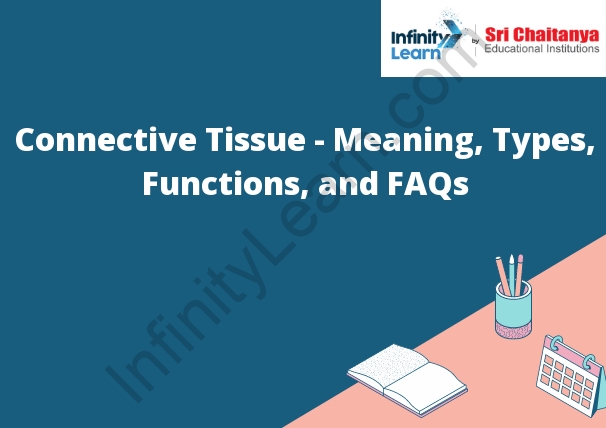Table of Contents
Connective Tissue
Connective Tissue – Meaning: Connective tissue is a type of tissue found in the body that connects and supports other tissues and organs. There are three main types of connective tissue: loose connective tissue, dense connective tissue, and elastic connective tissue. Each type has a different function and is made up of different types of cells.
- Loose connective tissue is the most abundant type of connective tissue in the body. It is made up of a variety of cells including fibroblasts, macrophages, and mast cells. Loose connective tissue is found in the skin, in the spaces between muscles and organs, and in the spaces surrounding blood vessels. Its primary function is to bind and support other tissues and organs.
- Dense connective tissue is made up of densely packed fibroblasts and is found in the tendons and ligaments that attach muscles to bones, in the dermis of the skin, and in the capsule that surrounds organs. Its primary function is to provide strength and support.
- Elastic connective tissue is made up of elastic fibres and is found in the walls of blood vessels, the lining of the lungs, and in the ligaments and tendons that attach muscles to bones. Its primary function is to provide elasticity and flexibility.

Define Connective Tissue
Connective tissue is a type of tissue that connects other tissues and organs in the body. It is made up of cells called fibroblasts, which produce a protein called collagen. Collagen gives connective tissue its strength and elasticity.
Key Takeaways about Connective Tissues
There are four types of connective tissues:
1. Connective tissue proper
2. Cartilage
3. Bone
4. Blood
1. Connective tissue proper is a type of connective tissue that supports and binds other tissues together. It is composed of a matrix of proteins and carbohydrates, and contains cells that help to maintain the tissue.
2. Cartilage is a type of connective tissue that is composed of a matrix of proteins and carbohydrates, and contains cells that produce and maintain the cartilage. Cartilage is a tough, flexible material that is found in the joints and in the nose, ears, and throat.
3. Bone is a type of connective tissue that is composed of a matrix of proteins and carbohydrates, and contains cells that produce and maintain the bone. Bone is a hard, calcium-rich material that provides structure and support for the body.
4. Blood is a type of connective tissue that is composed of a matrix of proteins and carbohydrates, and contains cells that transport oxygen and nutrients throughout the body. Blood also helps to fight infection and to clot when necessary.
Types of Connective Tissues
There are four types of connective tissues:
1. Bone
2. Cartilage
3. Fat
4. Muscle
1. Bone: Bone is a type of connective tissue that is composed of living cells called osteoblasts and osteoclasts, and a mineral called hydroxyapatite. The osteoblasts secrete the organic component of bone, called osteoid, and the osteoclasts break down bone. Bone is a hard, calcified connective tissue that provides support and protection for the body.
2. Cartilage: Cartilage is a type of connective tissue that is composed of living cells called chondrocytes and a matrix of proteins and glycoproteins. The chondrocytes secrete the matrix, which is composed of collagen and proteoglycans. Cartilage is a flexible, rubbery connective tissue that provides support and cushioning for the body.
3. Fat: Fat is a type of connective tissue that is composed of living cells called adipocytes and a matrix of proteins and glycoproteins. The adipocytes secrete the matrix, which is composed of collagen and proteoglycans. Fat is a soft, oily connective tissue that stores energy and insulation for the body.
4. Muscle: Muscle is a type of connective tissue that is composed of living cells called muscle fibers and a matrix of proteins and glycoproteins. The
Characteristics & Components of Connective Tissues
- Connective tissues are a type of soft tissue that connects, supports, and binds together other tissues and organs of the body. They are made up of cells called fibroblasts, as well as a variety of proteins, including collagen and elastin. Connective tissues have a few key characteristics, including the ability to stretch and recoil, as well as the ability to bind to other tissues.
- There are several different types of connective tissues, including loose connective tissue, dense connective tissue, and cartilage. Each type has a unique set of characteristics and serves a specific function in the body.
- Loose connective tissue is found in the skin, under the skin, and around organs. It is made up of a network of fibroblasts, collagen, and elastin, and provides strength and elasticity. Loose connective tissue also contains a variety of cells called mast cells, which are involved in the immune response.
- Dense connective tissue is found in the tendons and ligaments, which connect muscles to bones. It is made up of densely packed fibroblasts, collagen, and elastin, and is very strong and resilient.
- Cartilage is a type of connective tissue that is found in the joints and in the nose, ears, and throat. It is made up of a matrix of proteins and elastic fibers, and contains no blood vessels or nerves. Cartilage is strong and flexible
What are the Different Cells of Connective Tissues?
The cells of connective tissues are fibroblasts, mast cells, macrophages, and adipocytes.
Functional and Clinical Importance of Connective Tissue
Connective tissue is a type of tissue that supports and connects other tissues and organs in the body. It has a variety of functions, including providing structural support, storing energy, regulating fluid balance, and transporting nutrients. Connective tissue also plays a role in the immune system, and helps to heal injuries.









